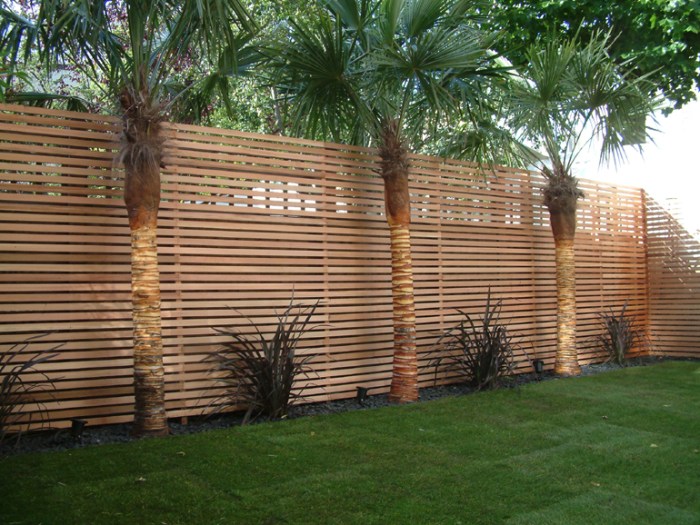The juxtaposition of clean, minimalist architecture and the lush, organic forms of palm trees presents a fascinating design challenge. This exploration delves into the harmonious integration of these seemingly disparate elements, examining how the architectural style, interior design, landscaping, and sustainable practices converge to create serene and visually stunning living spaces. We’ll investigate the specific species of palm trees best suited for different climates and architectural styles, analyzing their impact on both the exterior and interior aesthetics, and exploring the principles of eco-conscious design within this unique context.
From Mediterranean villas to Californian bungalows and tropical retreats, the incorporation of palm trees offers a unique opportunity to soften hard lines, introduce natural textures, and create a sense of tranquil seclusion. This study will analyze various design approaches, focusing on the interplay of light and shadow, the selection of complementary plant life, and the overall creation of a low-maintenance yet visually captivating environment.
The goal is to illustrate how careful planning and design can achieve a cohesive and sustainable blend of modern architecture and tropical elegance.
Architectural Styles
Minimalist architecture, characterized by its clean lines, simple forms, and functional design, finds a harmonious partner in the lush greenery of palm trees. The integration of these two elements creates aesthetically pleasing and environmentally conscious living spaces. This exploration delves into the synergy between minimalist design and the strategic placement of palm trees to enhance the overall architectural aesthetic.
Minimalist Home Styles Incorporating Palm Trees
Three distinct minimalist home styles can effectively incorporate palm trees into their landscaping: the Tropical Modern, the Mediterranean Minimalist, and the Californian Contemporary. Each style utilizes different palm species and placement strategies to achieve a unique visual impact.
Tropical Modern: This style emphasizes open-plan living spaces, natural materials like bamboo and sustainably sourced timber, and a focus on maximizing natural light and ventilation. The color palette is typically warm and earthy, featuring shades of beige, brown, and green. Tall, slender palm trees, such as the Arecaceae family’s Dypsis lutescens (Areca Palm) or Rhapis excelsa (Broadleaf Lady Palm), are strategically placed to create vertical lines that complement the building’s clean lines, while also providing shade and privacy.
The palms are often clustered near the house or planted in rows along walkways, creating a sense of enclosure without obstructing views.
Mediterranean Minimalist: This style draws inspiration from the architecture of the Mediterranean region, emphasizing whitewashed walls, stucco finishes, and terracotta roofing tiles. The color palette is bright and airy, featuring shades of white, cream, and blue. Smaller, more compact palm trees, such as the Chamaerops humilis (European Fan Palm) or Phoenix canariensis (Canary Island Date Palm), are used to create a sense of understated elegance.
These palms are often planted in groupings near patios or swimming pools, adding a touch of texture and visual interest without overwhelming the minimalist aesthetic. The use of drought-tolerant species aligns with the sustainability ethos often associated with minimalist design.
Californian Contemporary: This style blends modern aesthetics with the natural beauty of the Californian landscape. It often features large windows, open floor plans, and a strong connection to the outdoors. The color palette is neutral and earthy, featuring shades of gray, beige, and brown. A variety of palm trees can be incorporated, including the Washingtonia filifera (California Fan Palm) for a more dramatic effect or the Phoenix dactylifera (Date Palm) for a touch of classic Californian charm.
These palms are often planted strategically to frame views, provide shade, or create visual focal points. The landscaping typically includes native plants and drought-tolerant species, reflecting a commitment to environmental sustainability.
Palm Tree Use in Different Minimalist Architectural Styles
The use of palm trees varies significantly across different minimalist architectural styles, reflecting regional influences and design preferences.
Mediterranean Minimalist Architecture: Often utilizes smaller, more compact palm species like the Chamaerops humilis (European Fan Palm) and Phoenix canariensis (Canary Island Date Palm). These palms are strategically placed to complement the whitewashed walls and terracotta roofs, creating a sense of understated elegance and reflecting the region’s native flora. Placement often emphasizes proximity to outdoor living areas such as patios and courtyards.
Californian Minimalist Architecture: Leverages a wider variety of palm species, including the iconic Washingtonia filifera (California Fan Palm) and Phoenix dactylifera (Date Palm). The placement of these palms is often dictated by their ability to frame views, provide shade, or act as visual anchors within the landscape. Larger specimens can create a dramatic backdrop, while smaller palms can be used to accentuate specific features of the home’s design.
Tropical Minimalist Architecture: Frequently incorporates taller, more slender palm species such as the Dypsis lutescens (Areca Palm) and Rhapis excelsa (Broadleaf Lady Palm). These palms are often planted in clusters or rows to create a sense of enclosure and privacy while maintaining an open and airy feel. Their vertical lines complement the clean lines of the minimalist architecture, creating a harmonious visual balance.
Impact of Different Palm Tree Species on Minimalist Home Aesthetics
The choice of palm tree species significantly impacts the overall aesthetic of a minimalist home.
The Washingtonia filifera (California Fan Palm), with its large, fan-shaped fronds and tall trunk, creates a dramatic and imposing presence. It is well-suited for larger properties where its size can be accommodated without overwhelming the home’s design. In contrast, the Chamaerops humilis (European Fan Palm), with its smaller size and more delicate fronds, offers a more understated elegance, ideal for smaller spaces or where a less dominant presence is desired.
The Phoenix canariensis (Canary Island Date Palm), with its feathery fronds and arching leaves, provides a sense of graceful movement and texture, adding a touch of softness to the clean lines of minimalist architecture. The Dypsis lutescens (Areca Palm), with its multiple slender trunks and feathery foliage, creates a lush and tropical feel, ideal for tropical minimalist designs.
Interior Design & Palm Tree Integration

The integration of palm trees into minimalist home interiors offers a unique opportunity to blend the clean lines and simplicity of modern design with the natural beauty and vibrancy of tropical flora. This approach leverages the inherent calming effect of nature to create spaces that are both aesthetically pleasing and conducive to relaxation and well-being. Careful consideration of color palettes, texture, and lighting is crucial in achieving a harmonious and sophisticated aesthetic.
Minimalist design, characterized by its functionality and uncluttered spaces, provides an ideal backdrop for showcasing the sculptural forms of palm trees. Whether incorporated through artwork, potted plants, or even strategically placed silhouettes, palm trees introduce a sense of organic dynamism that contrasts beautifully with the structured simplicity of the architecture.
Mood Board: Three Minimalist Interior Design Styles Featuring Palm Trees
The following three styles demonstrate the versatility of palm tree integration within a minimalist context. Each style utilizes different color palettes, textures, and furniture to achieve a unique ambiance.
Style 1: Tropical Minimalism: This style embraces a vibrant, yet refined, tropical aesthetic. Imagine a living room with whitewashed walls, light wood flooring, and rattan furniture. The color scheme revolves around soft greens, sandy beige, and accents of turquoise. A large, potted Kentia palm stands in a corner, its fronds reaching towards the ceiling. Textures include smooth linen upholstery, woven baskets, and the natural grain of the wood.
The overall effect is one of relaxed sophistication, bringing the outdoors in without sacrificing a sense of order.
Style 2: Monochromatic Minimalism with Palm Accents: This style prioritizes a neutral palette with strategic pops of color. Consider a bedroom with gray walls, a charcoal gray bed frame, and white linens. A large-scale black and white photograph of palm trees dominates one wall, creating a dramatic focal point. Textures are primarily smooth and matte, with the exception of a plush, light gray rug.
The limited color palette enhances the drama of the artwork, while the palm tree image brings a sense of warmth and life to the space.
Style 3: Scandinavian Minimalism with Palm Tree Silhouette: This style combines the clean lines of Scandinavian design with the subtle presence of palm trees. Imagine a bathroom with white walls, light wood cabinetry, and a sleek, minimalist vanity. A delicate, almost abstract, silhouette of palm trees is etched onto a frosted glass shower door, allowing natural light to diffuse through the design while adding a touch of tropical elegance.
The color scheme is predominantly white and light gray, with small touches of natural wood and brass. The overall feeling is serene and airy.
Interior Space Design: Living Room, Bedroom, and Bathroom
The strategic placement of palm tree elements within different interior spaces significantly impacts the overall atmosphere.
Living Room: A large, strategically placed potted Areca palm in a simple ceramic pot acts as a natural room divider, separating the seating area from a reading nook. Its lush green foliage adds a touch of vibrancy and softens the hard lines of the minimalist furniture. The natural light filtering through the leaves creates dappled shadows, adding to the calming ambiance.
Bedroom: A framed botanical print featuring a stylized palm tree hangs above the bed, serving as a subtle yet elegant focal point. The muted colors of the print complement the neutral palette of the bedroom, while the palm tree imagery evokes a sense of tranquility and escape. A small, low-maintenance ZZ plant on a bedside table adds a touch of greenery without overwhelming the space.
Bathroom: A small, potted snake plant, known for its air-purifying qualities, is placed near the window. Its vertical lines complement the minimalist design, while its deep green color provides a calming contrast to the white tiles and fixtures. A framed print of palm leaves adds a subtle touch of tropical elegance without disrupting the overall clean aesthetic.
Natural Light and Shadow: Creating a Calming Atmosphere
The interplay of natural light and shadow is fundamental in achieving a serene atmosphere within a minimalist home incorporating palm tree elements.
Large windows, ideally positioned to maximize natural light exposure throughout the day, are crucial. The placement should consider the sun’s trajectory to avoid harsh direct sunlight while maximizing soft, diffused light. Interior lighting should complement the natural light, providing a warm and inviting glow in the evening. Recessed lighting or strategically placed floor lamps can highlight the texture of the palm tree fronds or the artwork featuring palm trees, adding depth and visual interest to the space.
The shadows cast by the palm trees themselves create dynamic patterns on the walls and floors, adding to the organic and calming feel of the environment.
Landscaping & Outdoor Spaces

Minimalist landscaping, when integrated with palm trees, offers a unique opportunity to create serene and low-maintenance outdoor spaces. The inherent elegance of palm trees complements the clean lines and uncluttered aesthetic of minimalist design, resulting in an environment that is both visually striking and practically efficient. Careful selection of plant species and a thoughtful approach to design are key to achieving this balance.
The principles of minimalist landscaping emphasize simplicity, functionality, and the use of natural materials. This approach translates seamlessly to the integration of palm trees, which require minimal intervention once established, aligning perfectly with the low-maintenance ethos of the design style. Strategic placement, mindful selection of complementary plants, and the careful consideration of hardscaping elements are crucial for creating a visually appealing and sustainable outdoor environment.
Minimalist Garden Design Incorporating Palm Trees
A minimalist garden featuring palm trees should prioritize clean lines, natural textures, and a limited color palette. The selection of companion plants should enhance the overall aesthetic without overwhelming the space. Grasses such as Ophiopogon japonicus (mondo grass) or Carex testacea (bronzesedge) offer textural contrast and require minimal upkeep. Succulents, like Agave species, add architectural interest and thrive in similar conditions to many palm trees.
Consider incorporating gravel pathways for easy maintenance and a clean, modern look. The overall effect should be one of calm and understated elegance.
Palm Tree Maintenance Requirements
The success of a minimalist palm-tree landscape depends heavily on choosing the right species for the specific climate and maintenance capabilities. Different palm varieties have varying needs regarding water, sunlight, and pruning. Understanding these requirements is vital for creating a sustainable and visually appealing garden.
| Name | Water Needs | Sunlight Requirements | Pruning Needs |
|---|---|---|---|
| Phoenix canariensis (Canary Island Date Palm) | Moderate to high, especially during establishment | Full sun | Minimal; remove dead fronds only |
| Washingtonia robusta (Mexican Fan Palm) | Moderate; drought-tolerant once established | Full sun | Moderate; regular removal of dead fronds is recommended |
| Chamaerops humilis (European Fan Palm) | Low to moderate; drought-tolerant | Full sun to partial shade | Minimal; remove dead fronds as needed |
| Rhapis excelsa (Broadleaf Lady Palm) | Moderate; prefers consistently moist soil | Partial shade to full shade | Minimal; primarily for shaping |
Minimalist Pool Area Design with Integrated Palm Tree Landscaping
Designing a minimalist pool area with integrated palm tree landscaping requires careful planning and selection of materials. The overall aesthetic should be clean and uncluttered, with a focus on natural materials such as stone, concrete, and wood. The pool itself could be a sleek, geometric design, contrasting beautifully with the organic forms of the palm trees. Lighting plays a crucial role in enhancing the ambiance.
Subtle, recessed lighting in the pool deck and around the palm trees can create a warm and inviting atmosphere at night. The use of natural materials like flagstone or polished concrete for the decking provides a low-maintenance and aesthetically pleasing surface. Strategically placed palm trees can provide shade and privacy, adding to the overall sense of tranquility.
For example, a row of Phoenix canariensis planted along one side of the pool could create a natural screen, while a smaller Rhapis excelsa could be placed near the pool’s edge for a softer touch. The overall design should emphasize clean lines, natural materials, and a minimalist color palette, creating a relaxing and visually stunning oasis.
Visual Representation & Mood

The interplay of architectural minimalism and the organic forms of palm trees creates a unique visual narrative, profoundly impacting the mood and atmosphere of a space. The juxtaposition of clean lines and natural curves offers a rich tapestry of aesthetic possibilities, from serene tranquility to vibrant energy. Careful consideration of color palettes, lighting, and textural contrasts is crucial in harnessing this potential.Image Descriptions Illustrating the Essence of Palm Trees and Minimalist Homes
Three Diverse Visual Representations
Three distinct images can effectively capture the essence of this architectural style. The first image depicts a stark white minimalist home, its sharp angles softened by the gentle sway of tall, slender coconut palms. The color palette is limited, featuring the pristine white of the house, the deep green of the palm fronds, and the clear, azure blue of a tropical sky.
Soft, diffused sunlight creates a calm, almost meditative mood. The second image showcases a low-slung, concrete minimalist home nestled amongst shorter, bushier date palms. The color palette here is more earthy, incorporating the warm beige of the concrete, the silvery-green of the date palm leaves, and the muted browns of the surrounding landscape. The lighting is more dramatic, with strong shadows cast by the palms, creating a sense of mystery and intrigue.
The third image portrays a glass-fronted minimalist home, its transparent walls reflecting the vibrant greens and blues of a lush tropical garden overflowing with various palm species. The color palette is vibrant and saturated, capturing the energy of the tropical environment. The light is bright and sunny, reflecting the optimism and vitality of the setting.
Sunlight and Shadow Interaction
Imagine a late afternoon scene. The sun, low in the west, casts long, dramatic shadows from the tall, slender silhouette of royal palms surrounding a minimalist home with clean, white stucco walls. The shadows stretch and dance across the smooth surfaces of the house, creating a dynamic interplay of light and dark. The angle of the sun highlights the texture of the stucco, emphasizing its subtle variations.
The warm, golden light of the setting sun bathes the scene in a tranquil, almost melancholic ambiance. The overall mood is one of serene contemplation, the stillness of the evening underscored by the gentle rustling of palm leaves. The contrast between the sharp lines of the architecture and the organic movement of the shadows creates a visually arresting scene, highlighting the beauty of both natural and man-made elements.
Textural Contrast
A close-up photograph reveals the stark contrast between the smooth, polished concrete walls of a minimalist home and the rough, textured surface of palm tree leaves. The concrete’s flawless surface reflects the light uniformly, while the palm leaves exhibit a complex interplay of light and shadow, highlighting their intricate venation and the subtle variations in their texture. The smooth, cool feel of the concrete is juxtaposed against the rough, slightly prickly texture of the palm fronds.
This visual contrast enhances the appreciation of both materials, emphasizing the deliberate design choices and the integration of natural and artificial elements. The photograph captures the essence of this contrast, creating a powerful visual statement that underscores the deliberate integration of natural and built environments.
Sustainability & Eco-Friendly Design
The integration of palm trees and minimalist homes presents a unique opportunity to create aesthetically pleasing and environmentally responsible living spaces. However, achieving true sustainability requires careful consideration of the environmental impact of landscaping choices and the materials used in construction. This section explores strategies for minimizing the ecological footprint of such projects, focusing on water conservation, material selection, and energy efficiency.
Palm Tree Species and Water Consumption
The selection of palm tree species significantly impacts water consumption. Species native to arid or semi-arid regions, such as certain varieties of Washingtonia (e.g., Washingtonia filifera, the California fan palm) and Phoenix (e.g., Phoenix dactylifera, the date palm), are generally more drought-tolerant than others. Conversely, species originating in tropical rainforests may require significantly more frequent irrigation.
For example, some species of Roystonea (royal palms) demand substantial water to thrive. Understanding the water requirements of each species is crucial for creating a sustainable landscape design, minimizing water waste, and promoting responsible water management practices such as utilizing greywater systems or employing efficient irrigation technologies like drip irrigation. Careful consideration of local rainfall patterns and soil conditions should also inform species selection.
Sustainable Landscaping Practices
Sustainable landscaping goes beyond choosing drought-tolerant plants. It encompasses a holistic approach to minimize environmental impact. This includes employing xeriscaping techniques, which focus on creating water-wise landscapes that require minimal irrigation. Mulching around plants helps retain soil moisture, reducing the need for watering. Selecting native plants further reduces the need for fertilizers and pesticides, as these species are adapted to the local climate and less susceptible to pests and diseases.
Integrating permeable paving materials in pathways and driveways allows rainwater to seep back into the ground, replenishing groundwater reserves and reducing runoff. Finally, the use of organic fertilizers and pest control methods contributes to a healthier ecosystem.
Sustainable Building Materials for Minimalist Homes
The construction of a minimalist home should prioritize the use of sustainable and locally sourced materials to minimize transportation emissions and support local economies. Examples include sustainably harvested timber, bamboo, recycled steel, and rammed earth. These materials offer comparable strength and durability to conventional materials while possessing a lower embodied carbon footprint. Bamboo, in particular, is a rapidly renewable resource with exceptional strength-to-weight ratio.
Recycled materials, such as reclaimed wood or recycled steel, reduce waste and lessen the demand for new resources. Rammed earth, a technique using compacted earth and stabilizers, provides excellent thermal mass and requires minimal energy for production. The selection of these materials directly contributes to a smaller carbon footprint for the entire project.
Energy Efficiency in Warm Climates
Designing an energy-efficient minimalist home in a warm climate requires leveraging natural ventilation and shading strategies. The orientation of the house is crucial. Placing the home to minimize direct solar exposure during peak hours reduces the need for air conditioning. Strategically placed palm trees provide natural shade, further reducing energy consumption. Overhanging eaves and strategically positioned windows can also help regulate indoor temperature.
Passive cooling techniques, such as cross-ventilation, can create comfortable indoor temperatures without relying heavily on mechanical systems. Incorporating thermal mass materials, such as rammed earth or concrete, helps regulate indoor temperature fluctuations by absorbing and releasing heat slowly. The use of high-performance insulation and energy-efficient windows further contributes to reduced energy consumption.
Final Conclusion

Ultimately, the successful integration of palm trees into minimalist homes hinges on a deep understanding of both architectural principles and the specific characteristics of various palm species. By thoughtfully considering factors such as water usage, sunlight requirements, and the visual impact of different palm types, designers can create spaces that are not only aesthetically pleasing but also environmentally responsible. The resulting synergy between clean lines and organic forms offers a pathway to creating tranquil, sustainable, and visually stunning homes that celebrate the beauty of both nature and modern design.
The exploration highlights the potential for a harmonious co-existence, showcasing how thoughtful design can transform a simple concept into a breathtaking reality.
Query Resolution
What are the best palm tree species for minimalist landscaping?
The optimal palm species depend on climate and aesthetic preferences. Mediterranean climates might suit the Canary Island Date Palm ( Phoenix canariensis) or Mediterranean Fan Palm ( Chamaerops humilis). Warmer climates might utilize the Adonidia ( Adonidia venusta) or Majesty Palm ( Ravenea rivularis). Research local climates and palm tree hardiness zones for the best choice.
How can I minimize maintenance for palm trees in a minimalist garden?
Choose slow-growing varieties, mulch around the base to retain moisture, and implement a regular, but not excessive, watering schedule based on the specific needs of your chosen species. Proper pruning, focused on removing dead fronds, also reduces maintenance demands.
Are there any pest or disease concerns with palm trees?
Yes, various pests and diseases can affect palm trees. Regular inspection for signs of infestation (e.g., insects, discoloration) is crucial. Consulting with a local arborist or horticulturalist can provide guidance on preventative measures and treatment options if needed.
How do I incorporate palm trees into a small minimalist home’s design?
In smaller spaces, strategically placed potted palms can add a touch of greenery without overwhelming the area. Consider using smaller varieties or those that grow vertically, maximizing vertical space. Artwork featuring palm trees can also bring the aesthetic indoors.
What are the sustainability considerations when choosing palm trees for landscaping?
Consider water usage – opt for drought-tolerant varieties in arid climates. Avoid invasive species that could negatively impact the local ecosystem. Support responsible sourcing of palm trees from reputable nurseries that practice sustainable cultivation methods.